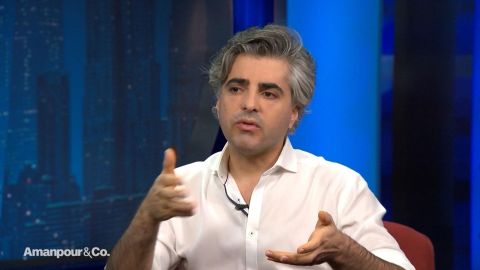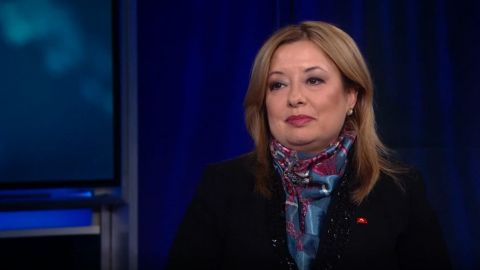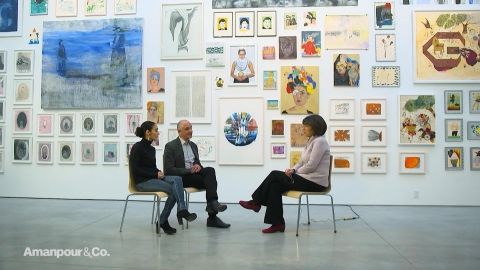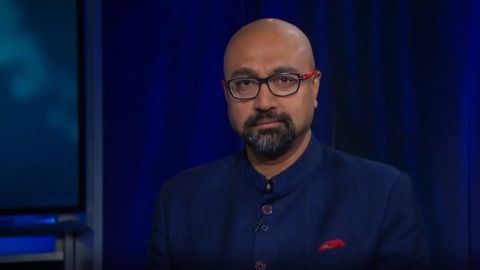Read Transcript EXPAND
CHRISTIANE AMANPOUR: And now we turn our attention to another inspirational woman. A new film, “The Cave,” documents the work of Syrian Dr. Amani Ballour as she manages an underground hospital in Ghouta outside Damascus during the war. Emmy Award-winning Feras Fayyad directed the film, which follows Dr. Ballour dealing with daily bombings and the ongoing threat of chemical attack. Our Hari Sreenivasan sat down with him to discuss “The Cave” and his own traumatic experience of being kidnapped and imprisoned in Syria. And, of course, his story reflects the incredible harshness that he had to endure.
(BEGIN VIDEOTAPE)
HARI SREENIVASAN: So you start with seven different hospitals. You’re getting footage from all these different places. How did you settle on this hospital and this — the one character that I want to ask you about, Dr. Amani? She’s the first woman leading, what, a staff of 140 people in this underground hospital. How did you settle on this?
FERAS FAYYAD, DIRECTOR, “THE CAVE”: When we start — when we continue shooting, I find out there is something special with Dr. Amani, because I kept talking to her, and find out, like, she have a very, very special way of leading the hospital. And then I figure out that she’s the first woman to lead a hospital in history of Syria. But she was also helping the women to work in the hospital. She built a role of equality. She built a space for these women to find their identity. And this is what the culture doing. What Dr. Amani doing, it’s really rare, but it’s brave and different level.
SREENIVASAN: And she is doing this in a culture that’s been very chauvinistic and sexist. There’s a clip of that in the film I want to show.
(BEGIN VIDEO CLIP, “THE CAVE”)
UNIDENTIFIED MALE (through translator): Then where can I get the medicine?
DR. AMANI BALLOUR, SYRIA (through translator): Al-Ghouta is besieged. There’s no medicine.
UNIDENTIFIED MALE (through translator): Find someone who can help me.
BALLOUR (through translator): What do you mean?
UNIDENTIFIED MALE (through translator): A male manager who can do a better job.
BALLOUR (through translator): So, are hospitals with male managers able to get you the medicine?
UNIDENTIFIED MALE (through translator): Yes. Women should stay home, not work. A woman belongs at home with her husband and children. It’s the man’s role to provide for the family.
UNIDENTIFIED MALE (through translator): Please allow me to interrupt. So, now me, as a doctor, has my work been bad in the presence of a female manager?
UNIDENTIFIED MALE (through translator): No, but…
UNIDENTIFIED MALE (through translator): Great. Hospitals don’t rely on one person. It’s teamwork. I will tell you one thing. We as doctors here, we found that, with Dr. Amani, the administration would be run well. We voted twice, and both times she won. Should we then tell her to stay home? That doesn’t make sense at all.
UNIDENTIFIED MALE (through translator): But she shouldn’t be a manager.
BALLOUR (through translator): No one can tell me not to work. No one tells me what to do.
(END VIDEO CLIP)
SREENIVASAN: Did you find any of this pervading the filmmaking process, meaning you have camera people who are there? When they’re shooting, are they thinking about her as the character, or are they starting to say, well, here’s this other guy, he’s pretty good too?
FAYYAD: Well, actually, this is one of the challenging in the films, because I want to focus on the female — work of the female in Syria. I want to make a case also for the women in the war, not as a victim, but also as a active, doing something, change something, as a heroine subject. The cinematographer was — all the time advised me, like, to go to film with a male, and their camera all the time moving from the female to the male. And then, when I see the footage, I surprise. I say, like, I want to follow the specific subject, because it’s not going to work. I want this — if you can’t do it, just tell me I can’t do it, see? But, for them, it was like — tell me like, no, it’s easier. We can have access. We can go there. And we can walk out with him. And we can do this.
SREENIVASAN: So, you kept telling them no, no, no, I don’t want more shots of this guy, I need more of her, she’s the character?
FAYYAD: Exactly. Exactly. Yes. And I told them, don’t do anything. Just sit down and let the camera observe it. You will get powerful, great footage. Don’t do anything. So you don’t need like to move around. You just like fit the camera on her, on her face, and move like a little bit away, and you can capture a lot of things. And this footage start to come out. And then themselves start to change, start to see her powerful, and start to…
SREENIVASAN: The cinematographers?
FAYYAD: Yes, start to recognize that she’s a powerful person in front of them. She’s great. And she is doing, that they never notice it before. They start to notice it through the camera, but also what the camera did, actually, it built the respect around Dr. Amani. The society around her start to focus on her and see her like something important.
SREENIVASAN: Partly because the camera was there.
FAYYAD: Because the camera on there. That — what the power of the change that the cinema can do in the right moment. And then I start to see there’s no better than this story to tell, because herself, Dr. Amani, moving, she’s a political figure. Everything, what she do, every single movement, it’s the story. And they need the people to think, because this film is a culture film. If we put the camera inside the hospital, the documentation of the war — the Russian warplane bombing the hospital, it’s enough to make a powerful story. But, alongside, there is a deeper, deeper level. It’s about the change in political and social level, that the society need to see it as a mirror in front of them.
SREENIVASAN: There is a clip that we’re going to play of her just dealing with some of the smallest victims and the patients that come in here. She talks to a young woman.
(BEGIN VIDEO CLIP, “THE CAVE”)
BALLOUR (through translator): Why are you crying? Are you afraid? You’re hypersensitive like me. Are you afraid? You’re hypersensitive like me. I cry easily. What is that on your hand?
UNIDENTIFIED FEMALE (through translator): Henna.
BALLOUR (through translator): Can I put it on like you? Your hands are more beautiful than mine. Just cover your ears. I do that when the bombs are falling and I’m scared. What’s your father’s job?
UNIDENTIFIED FEMALE (through translator): He’s not here anymore.
BALLOUR (through translator): Where is he?
UNIDENTIFIED FEMALE (through translator): He died.
BALLOUR (through translator): How did he die? Was he killed by a bomb?
UNIDENTIFIED FEMALE (through translator): By a car bomb.
BALLOUR (through translator): Was it a long time ago? Do you love your dad?
UNIDENTIFIED FEMALE (through translator): Yes.
BALLOUR (through translator): Were you sad when he died? He’s in a better place now.
(END VIDEO CLIP)
SREENIVASAN: There’s a scene right after that where she even has this conversation with a young girl about, what’s important to you? What could you — I mean, it — I don’t know if the girl is going to remember that conversation later in her life, but it might have been the first time she ever had a conversation that saw the possibility of becoming a doctor or a teacher as an outlet for her.
FAYYAD: This girl doesn’t have the — never opportunities to speak about her dream and about herself. When she felt somebody talking to her, she — relief. She felt that she have the first opportunities to talk.
SREENIVASAN: Let’s talk a little bit about this hospital. I mean, we see — we see a surgeon who’s operating without anesthesia. And he plays music for people off of his cell phone to try to keep them calm. Describe the conditions that this hospital is operating under.
FAYYAD: This is a hospital that doesn’t have any kind of medicine. They start to work on the medicine in their hand. And, sometimes, because the number of the people that are coming that are victims coming to the hospital, injuries, they’re coming to the hospital, it’s higher than what they have.
SREENIVASAN: The capacity?
FAYYAD: The capacity that they have. So they start to use different ways, like to make the patients feeling that they are more comfortable. Like, Dr. Salim, he tries to use different methods. And he’s the person who loved to use the music. And the music was like make the people comfortable, actually. Those people didn’t listen to music before, the victims. They are coming from this area. They don’t listen to the music. And the music — the classic music something they didn’t experience. When they start to experience, they start to experience their body, touch their body. This is what the change that make this.
SREENIVASAN: During the filming of this, we witness the repercussions of a chemical attack. And this is something that the Assad regime, the Russians all deny. And yet here you are. Your cinematographers are documenting people who are coming in. There’s a moment where the nurse says: I don’t understand. They all look healthy, but they’re dying. And then it starts to dawn on people and everybody else, like, let’s put masks on, et cetera. What was that process like?
FAYYAD: I can explain the chemical attack in this idea. If you are in a small room, and I bring 20 gallons of chlorine, and throw it, the smell of — the chlorine smell, it’s five or six times from that. They can make an attack that use, as Dr. Amani and Dr. Salim explain, because we don’t — we don’t know how — what the chemical attack is, what the material is there. She said, like, it’s the smell of the chlorine. But it is mixed with other chemical materials. So one of the condition of Dr. Amani was, when we film, we should not stop her from doing what she do, but also we should not touch the victims, because they don’t know what kind of the weapon used enough of the victims. And we try from 20 hour of documentation for the chemical attacks, me and my two editors to find a way like to make the people watch it and see who are the victim of the chemical attacks, what this means to using the chemical attack anywhere. I’m trying to put the people also in the position to understand, if they are fathers, mothers, or brothers or a citizen for any country, to understand what — how much this is dangerous. And we have the — all our — the responsibility about this. And nobody react about this, unfortunately. We need a real reaction, because using the chemical attack, the big threat for our world, is something cross the lines for any international law.
SREENIVASAN: “The New York Times” showed that there are still very specific bombings happening of hospitals, even though some of these hospitals were on a list of places that the U.N. had put out, saying these are places not to be targeted. They actually went down that list and targeted three or four hospitals at the same time.
FAYYAD: A lot of media being investigating this. Me, my — with my team, we documented more than 500, around 1,000 hours of documentations of the — inside the hospital. Our camera never moved outside of the hospitals. Seven hospitals been attacked intentionally. We documented that the U.N. visited the hospital — the cave. And after visiting of the U.N., the number of the bomb increase on the hospitals. This is so scary and put a lot of question about the responsibility of the humanitarians — humanitarian organization that visiting — visiting the hospital and the responsibility to protect the hospital. And this is a question, whether all of the U.N. now, what they have to do right now. And this is in front of them, in front of the world. My country now, the hospital of my county, the lowly place for the help, for surviving, it’s being bombed every day. And I have to tell everyone here, everyone listening and everyone seeing, this is — the death of every child, every person, every victim is the responsibility of every single person in this world will hear this and watch this.
SREENIVASAN: You have been kidnapped twice by the Syrian government. What happened to you?
FAYYAD: I was doing a documentary actually in the beginning of demonstration in Syria. And I try, like, to make a film and put what’s the change that this demonstration of democracy can bring. And in the middle of the documentation, I’m being kidnapped the first time and…
SREENIVASAN: So, not arrested, just taken?
FAYYAD: No, just taken. They take — they cannot be — they put my T- shirt on my face and take me. I didn’t know who had taken me until I arrive to underground jail, which — this is the underground jail. This jail, it’s just for the intelligence services jail. In Syria, there’s more than 12 branch of intelligence services. The number of the intelligence services branches more than the university and the schools in Syria, more than anything else. So they take me. And they — when I — when they threw me in my cell, which is like small cell like in this chair, which it’s just a toilet, a dirty toilet. And I have to sleep and stand there. And I have been torture every day. Every single day, they want to know why I’m filming this, what I’m doing. The filming is a crime for them.
SREENIVASAN: What was the torture?
FAYYAD: They was taking my nail. They was using the electricity on my sensitive part. They was hanging — like, hanging me, my hand in the roof. I have to stand on my finger for 24 hours without any food. They take me outside of the jail, of the cell to the three doors. They have to beat us and all — they beat us like until they go like to the toilet and back. And we see the bodies of the people that killed under torture. This is the first time. The second time, they did the same things. The first time. Three months is the second time, five months — 15 months. I have been jailed two time, 18 months, and just because I was doing a film in Syria.
SREENIVASAN: So how did you get out?
FAYYAD: The U.N. — they have some lawyers in the U.N. They have names of the journalists and filmmaker and artists being jailed in Syria. And the number was very high. So they put my names and other, and they released us. And they kept following us, because they want to capture us again. And this is the reason I left the country.
SREENIVASAN: So you’re now working on films still about and in Syria, but you can’t live there anymore. You can’t be there anymore because the Syrian government wants you. What happened to Dr. Amani, the central character in the movie? Where is she now?
FAYYAD: Dr. Amani now in Turkey. And she…
SREENIVASAN: Is she practicing as a doctor?
FAYYAD: She’s not allowed to practice doctor. She’s not allowed to work. She’s not allowed to do anything.
SREENIVASAN: Is she allowed to leave Turkey and…
FAYYAD: She allowed to leave Turkey, but she not allowed to do any — any job. She just have to sit and as a refugee, isn’t able to do anything.
SREENIVASAN: Do you know what happened to the hospital that “The Cave” is centered around?
FAYYAD: It’s taken by Russians. The area — all the area is being controlled by Russian — by Russian militaries now.
SREENIVASAN: Is it still functioning as a hospital?
FAYYAD: No, the hospital stopped functioning. They captured one of our doctor that been filmed in the movie. We remove a lot of footage for him, because he’s safely. And he’s now in the Syrian regime prison. And they tape two nurses, told them that what we did is fake news. There was — they make this — normally, the Syrian regime do something called the fake news on from — start from the beginning of the revolution in Syria. They capture the people who have different opinion from the government. And they put them in front of camera, force them to say something different. And they did capture two of our nurses and told them, like, what we did, it’s fake news.
SREENIVASAN: There were people in the hospital while we’re watching all these bombings. We’re happy that our central character is still alive, but there were, what, nurses killed, ambulance driver? Who were they?
FAYYAD: During the shooting of this movie, we have lost four medical worker, one ambulance driver, two nurses, and one of assistant of Dr. Amani’s. He’s management — one of the management team.
SREENIVASAN: What do you hope people get from this?
FAYYAD: What they will see now, it’s still happening there. And I hope they can write a letter for their representative here in U.S. and tell them, Syria need an action, direct action, to protect the civilians, places to protect the civilians, and other things, to be this film a testimony of crime against humanity. One day, when the criminals to not run from what they have done. This film will follow them forever, will keep a testimony on their crimes. And this could use as a like a testimony on one of this court that could bring those criminal to the court. This is what I wish. I’m not going to let those people who tortured the people and kill the people, that — to tell their lies. We are telling the truth. And the truth will come out, because it’s obvious. But we need to put it in front of the people in the right way.
SREENIVASAN: The documentary is called “The Cave.” Feras Fayyad, thanks so much.
FAYYAD: Thank you so much for having me here. Thank you for giving me the space to share this story.
About This Episode EXPAND
Bobby Ghosh joins Christiane Amanpour to discuss this year’s NATO summit and analyze tensions between Presidents Trump and Macron, then Gülnur Aybet explains President Erdogan’s role in the situation. Shirin Neshat and Hadi Ghaemi unpack the significance of a new exhibition of female Iranian artists. Feras Fayyad tells Hari Sreenivasan about his new documentary “The Cave.”
LEARN MORE



